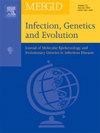流感相关急性坏死性脑病患儿的MicroRNA测序分析:早期诊断和治疗的潜在生物标志物
IF 2.6
4区 医学
Q3 INFECTIOUS DISEASES
引用次数: 0
摘要
急性坏死性脑病(ANE)继发于流感感染,其特点是暴发性神经功能恶化和高死亡率。潜在的机制尚不清楚,目前缺乏具体的治疗方法。因此,了解流感诱导的ANE的发病机制和确定诊断和治疗靶点至关重要。采集两组患者外周血样本:无ANE流感感染患者(轻度)和ANE流感感染患者(重度)。通过microRNA测序分析鉴定差异表达基因(DEG),然后进行基因本体(GO)和京都基因与基因组百科全书(KEGG)途径分析。使用qRT-PCR验证四种特异性mirna的表达水平。与轻度组相比,重度组有24个基因上调,67个基因下调。通过qRT-PCR验证hsa-miR-1290、hsa-miR-4657、has-miR-1231、hsa-miR-342-3p的表达水平,has-miR-4657、hsamiR- 342-3p的表达水平在重度组和轻度组之间存在显著差异。氧化石墨烯分析表明,deg主要参与细胞过程、细胞内解剖结构和蛋白质结合的积极调节。KEGG通路分析显示,DEGs主要富集于钙信号通路和轴突引导。下调的hsa-miR-4657和hsa-miR-342-3p可能通过调节钙通路和轴突引导与儿科流感患者ANE的发生有关。本文章由计算机程序翻译,如有差异,请以英文原文为准。
MicroRNA sequencing analysis in pediatric patients with influenza-associated acute necrotizing encephalopathy: Potential biomarkers for early diagnosis and therapy
Acute necrotizing encephalopathy (ANE) secondary to influenza infection is characterized by fulminant neurological deterioration and a high mortality rate. The underlying mechanisms remain unclear, and specific treatments are currently lacking. Therefore, understanding the pathogenesis and identifying diagnostic and therapeutic targets for influenza-induced ANE are crucial. Peripheral blood samples were collected from two groups: influenza-infected patients without ANE (mild) and influenza infection with ANE patients (severe). Differentially expressed genes (DEG) were identified through microRNA sequencing analysis, followed by Gene Ontology (GO) and Kyoto Encyclopedia of Genes and Genomes (KEGG) pathway analysis. The expression levels of the four specific miRNAs were validated using qRT-PCR. In the severe group, 24 genes were up-regulated, and 67 genes were down-regulated compared to the mild group. The expression levels of hsa-miR-1290, hsa-miR-4657, has-miR-1231, and hsa-miR-342-3p were validated by qRT-PCR, and the levels of has-miR-4657 and hsamiR- 342-3p showed significant differences between severe and mild groups. GO analysis demonstrated that the DEGs were predominantly involved in the positive regulation of cellular processes, intracellular anatomical structure, and protein binding. KEGG pathway analysis revealed that DEGs were mainly enriched in calcium signaling pathway and axon guidance. The down-regulated hsa-miR-4657 and hsa-miR-342-3p might be associated with the development of ANE in pediatric patients with influenza by regulation of calcium pathways and axon guidance.
求助全文
通过发布文献求助,成功后即可免费获取论文全文。
去求助
来源期刊

Infection Genetics and Evolution
医学-传染病学
CiteScore
8.40
自引率
0.00%
发文量
215
审稿时长
82 days
期刊介绍:
(aka Journal of Molecular Epidemiology and Evolutionary Genetics of Infectious Diseases -- MEEGID)
Infectious diseases constitute one of the main challenges to medical science in the coming century. The impressive development of molecular megatechnologies and of bioinformatics have greatly increased our knowledge of the evolution, transmission and pathogenicity of infectious diseases. Research has shown that host susceptibility to many infectious diseases has a genetic basis. Furthermore, much is now known on the molecular epidemiology, evolution and virulence of pathogenic agents, as well as their resistance to drugs, vaccines, and antibiotics. Equally, research on the genetics of disease vectors has greatly improved our understanding of their systematics, has increased our capacity to identify target populations for control or intervention, and has provided detailed information on the mechanisms of insecticide resistance.
However, the genetics and evolutionary biology of hosts, pathogens and vectors have tended to develop as three separate fields of research. This artificial compartmentalisation is of concern due to our growing appreciation of the strong co-evolutionary interactions among hosts, pathogens and vectors.
Infection, Genetics and Evolution and its companion congress [MEEGID](http://www.meegidconference.com/) (for Molecular Epidemiology and Evolutionary Genetics of Infectious Diseases) are the main forum acting for the cross-fertilization between evolutionary science and biomedical research on infectious diseases.
Infection, Genetics and Evolution is the only journal that welcomes articles dealing with the genetics and evolutionary biology of hosts, pathogens and vectors, and coevolution processes among them in relation to infection and disease manifestation. All infectious models enter the scope of the journal, including pathogens of humans, animals and plants, either parasites, fungi, bacteria, viruses or prions. The journal welcomes articles dealing with genetics, population genetics, genomics, postgenomics, gene expression, evolutionary biology, population dynamics, mathematical modeling and bioinformatics. We also provide many author benefits, such as free PDFs, a liberal copyright policy, special discounts on Elsevier publications and much more. Please click here for more information on our author services .
 求助内容:
求助内容: 应助结果提醒方式:
应助结果提醒方式:


